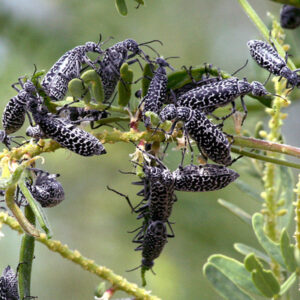BLISTER BEETLES
Everything you need to know about blister beetles
Blister beetles are one-half to one inch. long and have soft bodies. The head is broad and vertical. The section of the body between the head and the wings (prothorax) is narrower than the wings, and narrower than the head. It appears that the insect has a neck. The wings are soft and flexible, and the legs are long. Striped blister beetles are about 5/8 inch long and one-fourth as wide. They are gray to brown with yellow stripes running lengthwise of the wing covers. The ash-gray blister beetle is about 1/2 inch long and is completely gray. The black blister is about 1/2 inch long and solid black.
Damage
The larvae of the blister beetles destroys grasshopper egg pods. Infestations often occur during or just following a grasshopper outbreak. The black blister beetle adults are largely pollen feeders, but they also feed on alfalfa blossoms. Blister beetles

Blister beetles
The Hayestate Times
have an oily substance, cantharidin, in their body fluid that causes large blisters to form when a beetle is crushed.
Host
Blister beetles have a wide host range including alfalfa, clover, soybean, potato, tomato, melon, cotton, and eggplant.
Cantharidin
Cantharidin was first isolated in 1810. It is odorless and colorless.
It is secreted by the male blister beetle and given to the female during mating. Afterwards the female beetle will cover its eggs with it as a defense against predators.
Horses are highly sensitive to cantharidin and it is often deadly.
For horses a lethal dose is approximately 1 mg/kg of the horse's body weight.
Horses may be accidentally poisoned when fed bales of Alfalfa with blister beetles in them.
Cantharidin is comparative to cyanide and strychnine in toxicity.
Cantharidin will remain toxic in dead beetles.
There is no sampling method that will detect Cantharidin in cured baled hay or cubed or pelleted hay.
Cantharidin can not be broken down by heat or mechanical devices
Symptoms
Cantharidin can cause sever inflammation and the formation of blisters on the skin. If absorbed through the intestines, symptoms can include inflammation, blisters in the mouth, straining, temperature, increased heart rate and respiration, sweating, diarrhea and frequent urination within the first 24 hours.
This is accompanied by secondary infection and bleeding. Calcium levels in the horses may be drastically lowered and heart muscle tissues destroyed. Animals can die within 24 to 72 hours, so it is imperative to contact a veterinarian as soon as a blister beetle poisoning is suspected.
Toxic to Livestock
Cantharidin is toxic to livestock. Cantharidin is contained in the (blood) of the beetles and may contaminate forage directly when beetles are killed during harvest. Handling these insects may result in blisters, similar to a burn. Blister beetles have been a serious problem in alfalfa in the northern United States, the Midwest, and the south for many years. We have found West coast Alfalfa to be safest. We always recommend checking your alfalfa for extra security. Nothing is 100%. Your horse depends on you.
Beware Buyer
There is beautiful hay through out this country and Canada and very reputable producers who take every precaution in regards the beetle epidemic.
Beware of mechanical conditioners. Mechanical conditioning crimps the hay to create a soft green texture by removing moisture within a matter of hours. Unfortunately this kills the Blister Beetles trapping them in the hay. A dead beetle is deadlier than a live beetle! Please don't be taken by pretty hay, go for safe hay. Beware of a salesman that says that there are no Blister Beetles in their state. Blister Beetles are in every state in the United States. Educate yourself, check your hay before feeding. Your horse depends on you!
Know where your hay comes from
- Blister beetles are rarely found in Minnesota and Midwestern states.
- When buying hay, learn as much as possible about who produced it, where it was produced, when it was cut and maturity at harvest.
- If details aren't available, pay close attention to alfalfa hay that was mature or flowering when harvested.
- Detecting blister beetles in hay is practically impossible because the beetles tend to swarm. This means that only a few bales or parts of bales from an entire field may be infested.
- Beetles are very difficult to spot in bales. You may be able to see some dead, crushed beetles in small square bales.
- Discard any bales with beetles.
